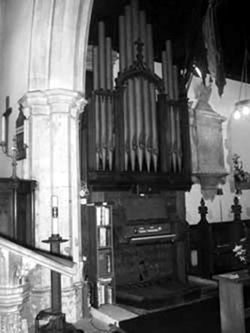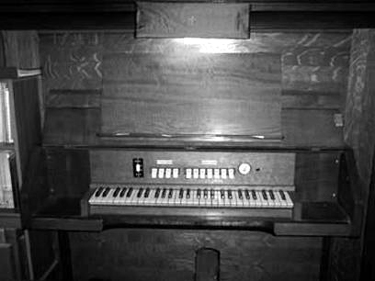From the Thorley Archives
'The Mongrel'
For many years now, the pipe organ in St James' Church has been
affectionately known as 'the mongrel', for no better reason that the fact that,
as it stands today, the instrument has been brought together over a number of
years from a variety of different sources.

Whilst still obviously operational, its chequered history means that there are
serious shortcomings in both its functionality and its very restricted ability
to cope with the tonal and dynamic variation so much associated with even a
relatively 'basic' pipe or digital organ.
Standing in its present form since the early 1980s, our instrument
has only a single manual (or keyboard) controlled by just seven tabs, all of
which, apart from the normal octave variations, when operated individually sound
depressingly similar. There are no reed (or brass) stops with which to colour
certain types of music - even basic pieces like 'The Prince of Denmark's March
aka 'The Trumpet Voluntary', which is used so often for weddings, has, sadly,
to forego its distinctive 'brass' quality, because the St James' organ simply
does not possess that facility.
The fact that each of the seven stops does not have its own complete rank of
pipes - certain voices 'borrow' from other ranks in certain areas - leads, in
some instances, to a marked inconsistency of tone within a given setting, or
combination of stops.

A further drawback of not having a second manual (the swell,
controlled by pedal through the swell box) is that one cannot achieve a smooth
crescendo or diminuendo, a factor particularly important when accompanying the
choir or solo singers. The crescendo pedal on the Church organ can only achieve
an unedifying 'jump' up or down in volume from any given setting.
Conversely, and in total contradiction to the shortcomings listed
above, the two and a half octave pedal board would do justice to an instrument
of far greater stature. This is just one illustration of the ill-matched components
that, over the years, have been cobbled together to form what currently passes
as our Church organ - 'The Mongrel'.

In the course of my twenty years' service at St James, apart
from regular tuning (a necessity for pipe organs), the only serious expenditure
devoted to our instrument took place in the early nineties, when the whole organ
was re-wired - an action necessitated by the disintegration of the old canvas
covering leading to regular 'shorting-out'. The organ had suffered 'trauma'
of an unrelated nature two years previously when, during the course of the re-wiring
of the Church, contractors had removed a number of organ pipes to gain access
to the switchgear located in the Vestry behind the organ. In the course of their
work, they proceeded to clamber all over the top of the unprotected instrument,
carelessly dropping various pieces of cable, clips, etc into the open holes
of the wind chamber, causing numerous malfunctions and massive de-tuning as
a result of their cavalier attitude. To this day, despite the best efforts of
our Organ Tuner, there is no guarantee that electrical debris is not resting
somewhere within the bowels!
Over the years, enquiries about various ways of upgrading to
a more substantial instrument have met with the same response - in essence,
any such work would not be cost-effective.
SO, with at least the Church congregation itself stabilised,
even showing positive signs of increase, now would appear to be the ideal time
to offer the worshippers of St James the prospect of a more 'legitimate' instrument,
worthy of a Church building steeped in centuries of history.
Simon Dellow
Director of Music
Additional Information
The Friends of St James archive has an extract copied from a book (title unknown),
headed The Parish Church of St James', Thorley, and including the following:
'The Organ The old pipe organ was rebuilt in 1897 to commemorate Queen Victoria's
Jubilee. A new electric organ was installed in 1964, the gift of Mrs Robinson,
the wife of Canon Robinson, in memory of her Mother. A number of the old pipes
were retained to make an effective facade.'
Our Terrier & Inventory records an entry:
'Organ - built by Leighton Organs, 13 - 15 Vicarage Lane, Wing, Leighton Buzzard,
Bedfordshire. Dated 1980.'
Postscript
Following a fund raising campaign by the Friends of St James,
the Mongrel was finally removed and, on 6 May 2010, replaced by a 37 Stop Two
Manual Allan electronic organ.
From the Archives